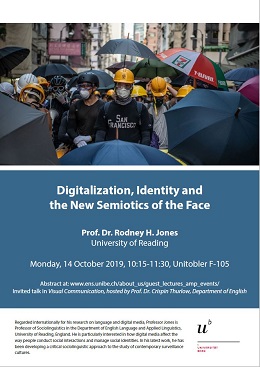
Digitalization, Identity and the New Semiotics of the Face
Rodney H. Jones
University of Reading
This lecture focuses on the impact of facial recognition technology on the way people regard the face both as a semiotic marker of identity and as a resource for everyday actions and political resistance. It explores the extent to which tools from sociolinguistics and discourse analysis, particularly more recent work on sociolinguistics and embodiment, can shed light on the way digitalization has complicated the relationship between identity and identification and altered social practices around such things as citizenship, trust, criminality and dissent.
The lecture begins with a historical overview of technologies of facial recognition, from the work on criminal identification developed in the 19th century by such figures as Alphonse Bertillon and Francis Galton, to late 20th century studies on the classification of facial expressions by the likes of Paul Ekman, to more recent advances in digital facial recognition and the integration of such technologies into different domains of social life from the playful (e.g. automatic ‘tagging’ of friends on social media sites) to the serious (e.g. biometric facial recognition at immigration check points; mass surveillance of citizens using CCTV cameras equipped with facial recognition capabilities). I argue that each of these advances has represented a shift in the way the face is conceptualized as both a semiotic object and as a pragmatic resource.
Next, I focus on the social construction and political consequences of automated facial recognition for the purposes of surveillance, observing how urban facial recognition programs have transformed the face from an emblem of identity to an index of (potential) criminal behaviour. I discuss the ways surveillance using facial recognition is discursively constructed in commercial, media and political discourse in places such as China, the UK and the US and how ‘playful’ and ‘social’ applications of these technologies have contributed to the increased securitization of identity and the normalization of surveillance.
Finally, I consider the inventive responses to automated facial recognition by political dissidents, taking as a case study the way participants in the recent protests in Hong Kong have devised methods of resistance which don’t just disrupt the technological capabilities of surveillance systems but also reclaim the face as site for identity construction through the creative design of different kinds of facial coverings and the iconization of facial obfuscation as a potent rhetorical tool for political resistance.